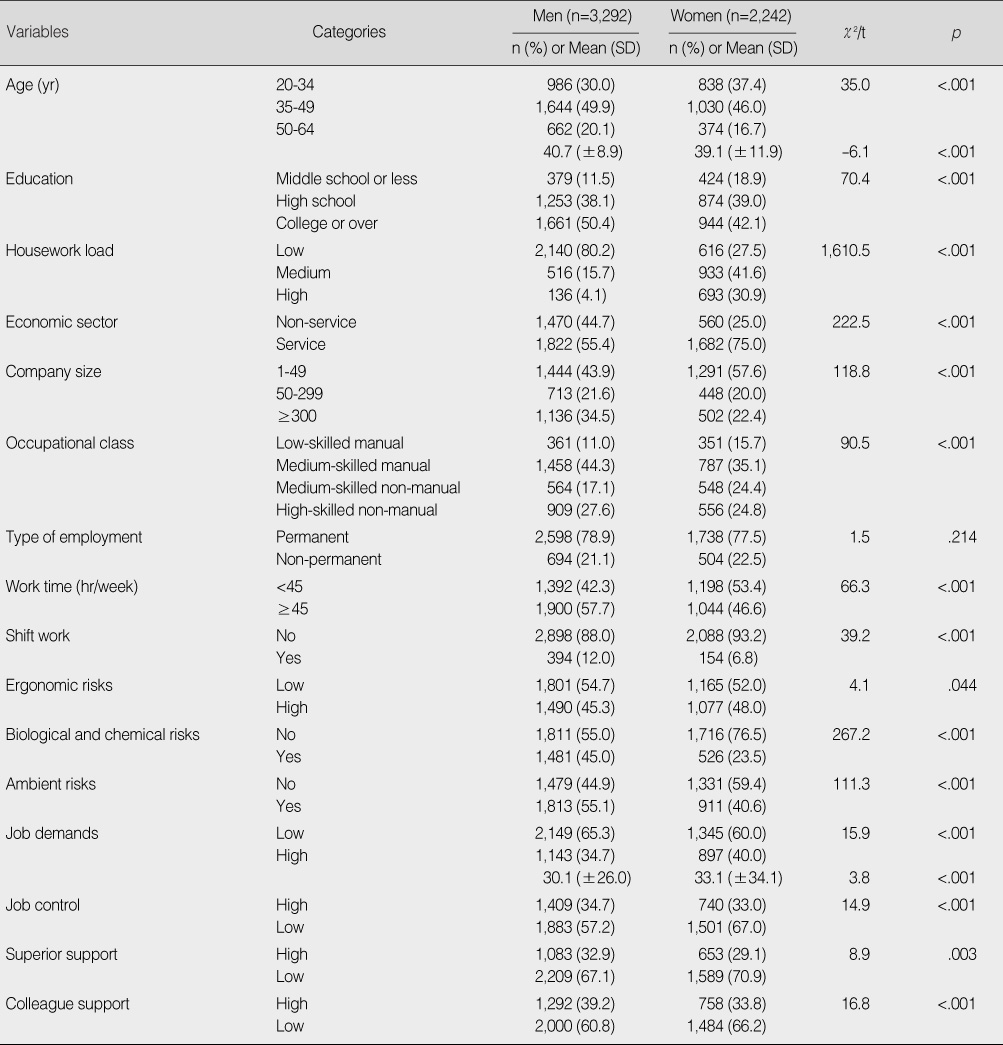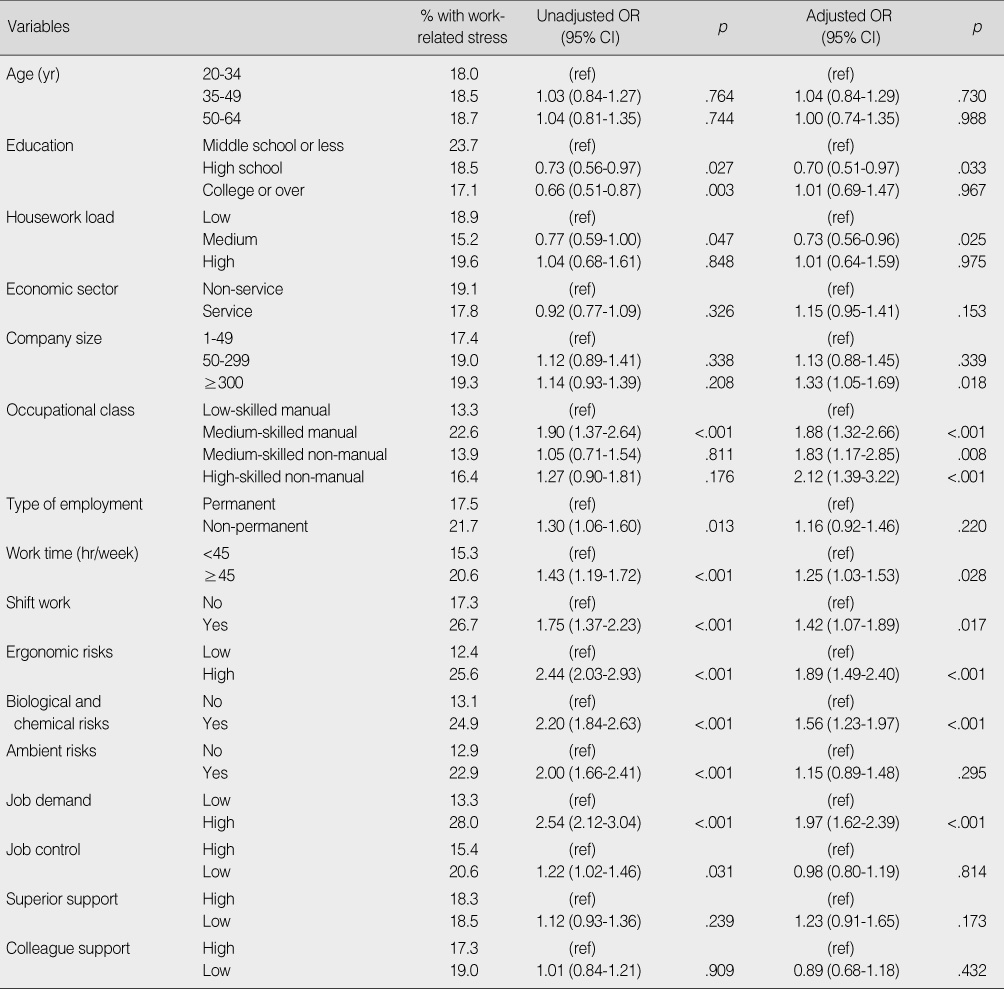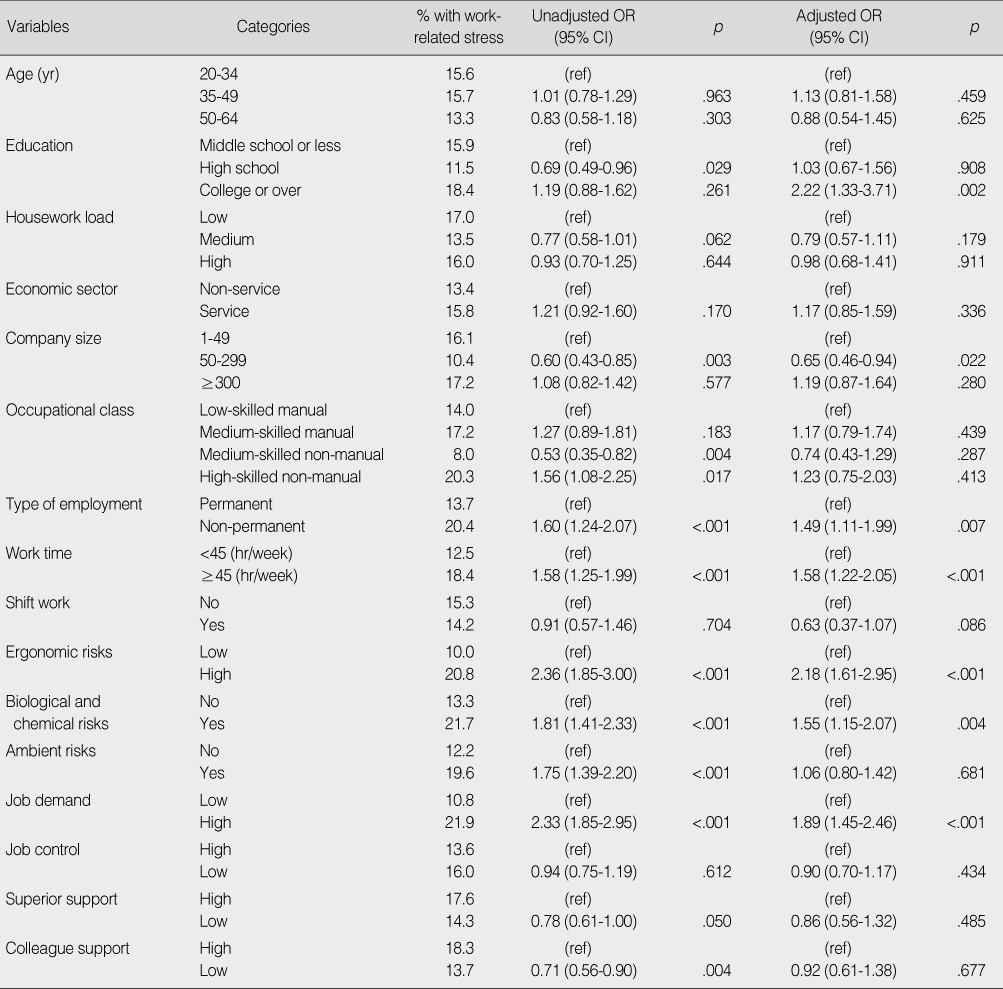Articles
- Page Path
- HOME > J Korean Acad Nurs > Volume 39(4); 2009 > Article
-
Original Article
- Work-related Stress and Risk Factors among Korean Employees
- Eun Sook Choi, Yeongmi Ha
-
Journal of Korean Academy of Nursing 2009;39(4):549-561.
DOI: https://doi.org/10.4040/jkan.2009.39.4.549
Published online: August 31, 2009
1Full-time Lecturer, The Institute of Nursing Science, College of Nursing, Kyungpook National University, Daegu, Korea.
2Doctoral Student, School of Nursing, University of North Carolina at Chapel Hill, NC, USA.
- Address reprint requests to: Ha, Yeongmi. School of Nursing, University of North Carolina at Chapel Hill, Carrington Hall, Campus Box 7460, Chapel Hill, NC 27599-7460, USA. Tel: 919-943-0262, Fax: 919-966-7298, ha@email.unc.edu
• Received: March 11, 2009 • Accepted: July 23, 2009
Copyright © 2009 Korean Society of Nursing Science
Abstract
-
Purpose
- Work-related stress and risk factors among Korean employees were identified in this study.
-
Methods
- Data were obtained from employees aged 20 to 64 using the Korean Working Conditions Survey 2006 (KWCS). Multiple logistic regression analysis using SAS version 9.1 was performed to examine risk factors of work-related stress by gender.
-
Results
- The age-adjusted prevalence of work-related stress among male and female employees was 18.4% and 15.1% respectively. After adjustments for multiple variables among both male and female employees, there was a significant relationship between work-related stress and risk factors including education, company size, work time, ergonomic risks, biological·chemical risks, and job demands. The significant variables for male employees were housework load, occupational class, and shift work, and for female employees, type of employment.
-
Conclusion
- There is a need to develop and support intensive stress management programs nationally giving consideration to work-related stress associated with working time, physical working environment, and job demands. Based on gender specific approaches, for male employes, stress management programs should be developed with consideration being given to occupational class and shift work. For stress management programs for female employees, consideration needs to be given to permanent employment status, specifically those in small companies.
- 1. Ahn J, Kim D, Lee S. Nonstandard workers and policy implication (III). 2003;Seoul, Korea Labor Institute.
- 2. Beehr TA, Farmer SJ, Glazer S, Gudanowski DM, Nair VN. The enigma of social support and occupational stress: Source congruence and gender role effects. Journal of Occupational Health Psychology. 2003;8:220–231.ArticlePubMed
- 3. Burchell B, Fagan C, O'Brien C, Smith M. Working conditions in the European Union: The gender perspective. 2007;Retrieved February 10, 2009. Available from: URL:http://www.eurofound.europa.eu/pubdocs/2007/108/en/1/ef07108en.pdf.
- 4. Chang SJ, Kang DM, Kang MG, Koh SB, Kim SA, Kim SY, et al. Standardization of job stress measurement scale for Korean employees (The 2nd year project). 2004;Incheon, Occupational Safety and Health Research Institute, Korea Occupational Safety and Health Agency.
- 5. Chang SJ, Koh SB, Kang MK, Cha BS, Park JK, Hyun SJ, et al. Epidemiology of psychosocial distress in Korean employees. Korean Journal of Preventive Medicine. 2005;38:25–37.
- 6. Cho TR. Workers' job stress status and related factors-Using Korean occupational stress questionnaire short form-. Korean Journal of Occupational Health Nursing. 2006;15:58–71.
- 7. Costa G. The problem: Shiftwork. Chronobiology International. 1997;14(2):89–98.ArticlePubMed
- 8. Daniels K. Perceived risk from occupational stress: A survey of 15 European countries. Occupational and Environmental Medicine. 2004;61:467–470.PubMedPMC
- 9. European Foundation for the Improvement of Living and Working Conditions. Quality report of the European working conditions survey. 2007;Retrieved February 10, 2009. Available from: URL:http://www.dataarchive.ac.uk/doc/5639%5Cmrdoc%5Cpdf%5C5639userguide.pdf.
- 10. Fagan C, Burchell B. Gender, jobs and working conditions in the European Union. 2002;Retrieved February 10, 2009. Available from: URL:http://www.eurofound.europa.eu/pubdocs/2002/49/en/1/ef0249en.pdf.
- 11. Hawksley B. Work-related stress, work/life balance and personal life coaching. British Journal of Community Nursing. 2007;12:34–36.ArticlePubMed
- 12. Health and Safety Executive. Stress at work-A guide for employers. 1995;Sudbury, Health and Safety Executive.
- 13. Hong KJ, Tak YR, Kang HS, Kim KS, Park HR, Kwag WH, et al. Job stress, job satisfaction, and health of women who work in the professional jobs: Nurse and teachers. Journal of Korean Academy Nursing. 2002;32:570–579.
- 14. Hur SO, Chang SS, Koo JW, Park CY. The assessment of stress between white and blue collar workers by using psychosocial well-being index. Korean Journal of Preventive Medicine. 1996;29:609–616.
- 15. Jung HS, Kim HY, Lee HK, Yi YJ, Kwon YS. A structural equation modeling on the factors of stress and coping strategies of married working women. Korean Journal of Occupational Health Nursing. 2001;10:93–109.
- 16. Kim YG, Yoon DY, Kim JI, Chae CH, Hong YS, Yang CG, et al. Effects of health on shift-work-general and psychological health, sleep, stress, quality of life. Korean Journal of Occupational Environmental Medicine. 2002;14:247–256.ArticlePDF
- 17. Koh SB, Son M, Kong JO, Lee CG, Chang SJ, Cha BS. Job characteristics and psychosocial distress of atypical workers. Korean Journal of Occupational Environmental Medicine. 2003;16:103–113.ArticlePDF
- 18. Korea National Statistical Office. Korean Statistical Information Service: Economically active population survey by age, gender group. 2006;Retrieved January 15, 2009. Available from: URL:from http://www.kosis.kr.
- 19. Korean standard industrial classification. Korea National Statistical Office. 2007a;Retrieved January, 15, 2009. Available from: URL:http://www.nso.go.kr/std2006/k07a_0000/k07ab_0000/k07ab_0000.html.
- 20. Korean standard classification of occupations. Korea National Statistical Office. 2007b;Retrieved January 15, 2009. Available from: URL:http://www.nso.go.kr/std2006/data/KSCO_6_1.hwp.
- 21. Krantz G, Berntsson L, Lundberg U. Total workload, work stress and perceived symptoms in Swedish male and female white-collar employees. European Journal of Public Health. 2005;15:209–214.ArticlePubMed
- 22. Kwon S. The study on gender equality in the family by type of employment of married women. Korean Journal of Social Welfare. 2003;52:201–221.
- 23. Lee MS. Working environments and working conditions affecting workers' stress symptoms. Journal of Korean Society for Health Education and Promotion. 2002;19:107–120.
- 24. Oh YA, Lee MS, Rhee KY. Relationship between manufacturing workers' job conditions and stress. Korean Journal Occupational Environmental Medicine. 2002;14:301–314.ArticlePDF
- 25. Parent-Thirion A, Fernández Macías E, Hurley J, Vermeylen G. Fourth European working conditions survey. 2007;Retrieved January 10, 2009. Available from: URL:http://www.eurofound. europa.eu/publications/htmlfiles/ef0698.htm.
- 26. Park J, Lee N. First Korean working conditions survey: A composition between South Korea and EU. Industrial Health. 2009;47:50–54.PubMed
- 27. Park JS, Lee GH, Kim JH. Report on Korean working conditions survey in 2006. 2007;Incheon, Occupational Safety and Health Research Institute, Korea Occupational Safety and Health Agency.
- 28. Rule of industrial health standard. Ministry of government legislation. 2009;01 01 Retrieved May 22, 2009. Available from: URL: http://www.law.go.kr.
- 29. Virtanen P, Vahtera J, Kivimäki M, Pentti J, Ferrie J. Employment security and health. Journal of Epidemiology and Community Health. 2002;56:569–574.ArticlePubMedPMC
REFERENCES
Figure & Data
REFERENCES
Citations
Citations to this article as recorded by 

- The Effect of Occupational Stress on the Psychological Well-Being of Healthcare Workers: Basis for Stress Management Interventions
LOVELY V. ECHALAR
International Journal of Innovative Science and Research Technology (IJISRT).2024; : 391. CrossRef - The association between nutrition label utilization and disease management education among hypertension or diabetes diagnosed in Korea using 2018 Community Health Survey: a cross-sectional study
Miran Jin, Jayeun Kim, Kyuhyun Yoon
Korean Journal of Community Nutrition.2023; 28(1): 38. CrossRef - Associations of extended work, higher workloads and emotional work demands with sleep disturbance among night-shift workers
Bo Min Jeon, Su Hyun Kim
BMC Public Health.2022;[Epub] CrossRef - Psychological stress, smoking, and hazardous drinking behaviors in South Korea: findings from the Korea National Health and Nutrition Examination Survey
Hyunjoon Lee, Harold H. Lee, Augustine Kang, Yoojin Cha, Don Operario
Journal of Substance Use.2021; 26(1): 13. CrossRef - Job Stress and Cardiometabolic Lifestyle Modification Behaviors Among Workers in High-risk and Low-risk Workplaces
Jiyeon Jung, Jina Choo, Sooyeon Park, Jihyun Moon, Songwhi Noh
Journal of Occupational & Environmental Medicine.2021; 63(6): e346. CrossRef - Sex and Gender Differences in Occupational Hazard Exposures: a Scoping Review of the Recent Literature
A. Biswas, S. Harbin, E. Irvin, H. Johnston, M. Begum, M. Tiong, D. Apedaile, M. Koehoorn, P. Smith
Current Environmental Health Reports.2021; 8(4): 267. CrossRef - Effects of a Yoga Program in Reducing Cardiovascular Disease Risk Factors in Workers of Small Workplaces: A Pilot Test
Won Ju Hwang, Jin Ah Kim, Ji Sun Ha
Sustainability.2020; 12(23): 10038. CrossRef - Impacts of family status and gender on the relationships between job demands, job control, and distress
Sehoon Kim, Hyounju Kang, Boreum Ju
European Journal of Training and Development.2019; 43(3/4): 322. CrossRef - Relationship between stress-related psychosocial work factors and suboptimal health among Chinese medical staff: a cross-sectional study
Ying-Zhi Liang, Xi Chu, Shi-Jiao Meng, Jie Zhang, Li-Juan Wu, Yu-Xiang Yan
BMJ Open.2018; 8(3): e018485. CrossRef - Association of stress, depression, and suicidal ideation with subjective oral health status and oral functions in Korean adults aged 35 years or more
Young Sun Kim, Han-Na Kim, Jung-Ha Lee, Se-Yeon Kim, Eun-Joo Jun, Jin-Bom Kim
BMC Oral Health.2017;[Epub] CrossRef - Mediating Role of Psychological Capital in Relationship between Occupational Stress and Turnover Intention among Nurses at Veterans Administration Hospitals in Korea
Hee-Yun Yim, Hyun-Ju Seo, Yoonhyung Cho, JinHee Kim
Asian Nursing Research.2017; 11(1): 6. CrossRef - Association between supervisors’ behavior and wage workers’ job stress in Korea: analysis of the fourth Korean working conditions survey
Shin Uk Kang, Byeong Jin Ye, ByoungGwon Kim, Jung Il Kim, Jung Woo Kim
Annals of Occupational and Environmental Medicine.2017;[Epub] CrossRef - Association of Job Stress with Health-promoting Behaviors and Health Status in Clinical Nurses
Jung-Suk Kim, Chun-Ja Kim
Korean Journal of Occupational Health Nursing.2016; 25(4): 311. CrossRef - The psychosocial status of the family members of rheumatoid arthritis patients in Korea
Sang Wan Chung, You Jung Ha, Eun Ha Kang, Yun Jong Lee, Yeong Wook Song
Rheumatology International.2016; 36(5): 719. CrossRef - A Study on the Characteristics of Injured Workers Rate and Work Environment of Male Workers for over 40 years
Kil-Yong Choi, Kyung-Soo Yang
The Korean Journal of Health Service Management.2016; 10(1): 131. CrossRef - Effects of an internet-based lifestyle intervention on cardio-metabolic risks and stress in Korean workers with metabolic syndrome: A controlled trial
Chun-Ja Kim, Elizabeth A. Schlenk, Se-Won Kang, Jae-Bum Park
Patient Education and Counseling.2015; 98(1): 111. CrossRef - A Comparative Study on Job Satisfaction of Road Freight Transportation Industry Workers by Type of Employment
Heon Jong YOO, Seung Bum AHN
Journal of Korean Society of Transportation.2015; 33(4): 368. CrossRef - Effect of Obesity and Psychological Stress on Oral Health
Soo-Hwa Kim, Sun-Mi Lee
Journal of dental hygiene science.2015; 15(2): 119. CrossRef - Association Night-Shift and Long Working-Hours Effects on Subjective Insomnia in Korean Workers: The Third Korean Working Conditions Survey
Chae-Bong Kim, Tae-Young Jung, Seoung-Min Han
The Korean Journal of Health Service Management.2015; 9(1): 41. CrossRef - Under and Over Employment and Working Conditions
Kyung Yong Rhee, Se Wook Song, Young Sun Kim
Journal of Korean Society of Occupational and Environmental Hygiene.2014; 24(4): 536. CrossRef - Prevalence and Associated Risk Factors of the Metabolic Syndrome in the Korean Workforce
Dae Ryong KANG, Yeongmi HA, Won Ju HWANG
Industrial Health.2013; 51(3): 256. CrossRef - Health Status and Affecting Factors related to Job among Korean Women Employees
Eun-Young Hong, Sang-Dol Kim
Journal of the Korea Academia-Industrial cooperation Society.2012; 13(9): 4107. CrossRef - Influence of task demands on occupational stress: Gender differences
Susana García Herrero, Miguel Ángel Mariscal Saldaña, Javier García Rodriguez, Dale O. Ritzel
Journal of Safety Research.2012; 43(5-6): 365. CrossRef - Analysis on Stress and Dietary Attitudes of Male Employees
Mi-Ae Lee, Eun-Ju Lee, Hye-Kyung Soh, Bong-Soon Choi
Korean Journal of Community Nutrition.2011; 16(3): 337. CrossRef - Spirituality and Stress Responses in Small Industry Employees
Sook Lee
Journal of Korean Academy of Psychiatric and Mental Health Nursing.2010; 19(2): 220. CrossRef - Health Behaviors by Job Stress Level in Large-Sized Company with Male and Female Workers
Hyunju Park, Hye-Sun Jung
Journal of Korean Academy of Nursing.2010; 40(6): 852. CrossRef
Work-related Stress and Risk Factors among Korean Employees
Work-related Stress and Risk Factors among Korean Employees
Characteristics of Korean Employees aged 20-64 yr by Gender
Unadjusted Odds Ratios (OR) and Adjusted Odds Ratios (OR) for Work-related Stress as Dependent Variable and the Risk Factors as Independent Variables among Korean Employed Men (N=3,292)
Unadjusted Odds Ratios (OR) and Adjusted Odds Ratios (OR) for Work-related Stress as Dependent Variable and the Risk Factors as Independent Variables among Korean Employed Women (N=2,242)
Table 1
Characteristics of Korean Employees aged 20-64 yr by Gender
Table 2
Unadjusted Odds Ratios (OR) and Adjusted Odds Ratios (OR) for Work-related Stress as Dependent Variable and the Risk Factors as Independent Variables among Korean Employed Men (N=3,292)
Table 3
Unadjusted Odds Ratios (OR) and Adjusted Odds Ratios (OR) for Work-related Stress as Dependent Variable and the Risk Factors as Independent Variables among Korean Employed Women (N=2,242)
 KSNS
KSNS
 E-SUBMISSION
E-SUBMISSION



 Cite
Cite

